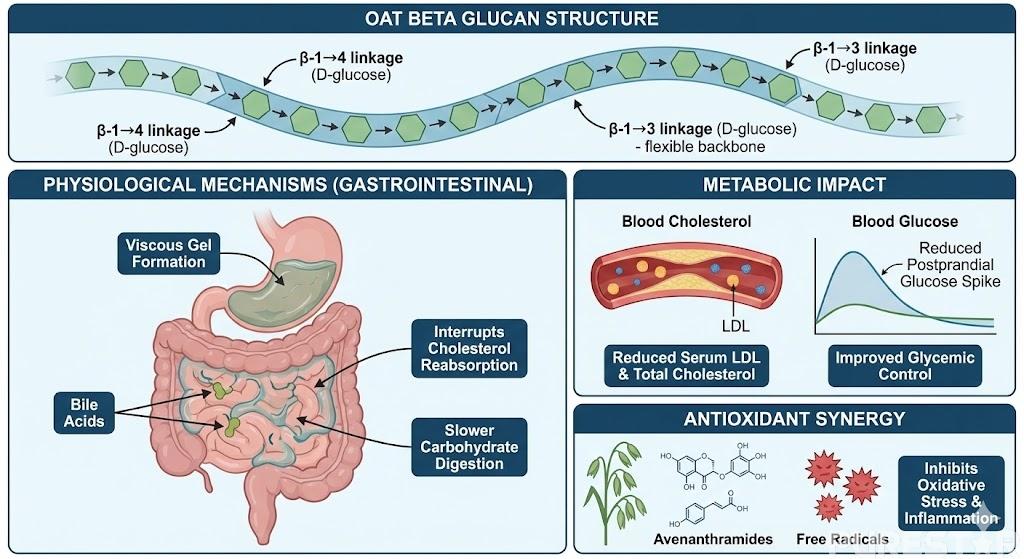Oats, a cereal crop of the genus Avena, have evolved from a traditional staple into a globally recognized functional ingredient, largely due to the unique biological properties of Oat beta glucan and its associated antioxidant components. While Russia, Canada, and the United States remain the world’s primary oat producers, China’s cultivation of naked oats has historically been underutilized, largely confined to simple consumption and animal feed. Only in recent years, driven by rising consumer awareness of metabolic health and immune resilience, has interest surged in the scientific and commercial potential of oats. Central to this transformation is oat beta glucan, a soluble dietary fiber whose structural characteristics directly shape its physiological activities and position oats as a leading contender in the future of functional foods.
Unlike other cereal polysaccharides, oat beta glucan consists of D-glucose units joined by β-1→3 and β-1→4 glycosidic linkages in a distinctive molecular configuration. This structural pattern is not merely a biochemical curiosity—it is the reason behind the compound’s remarkable viscosity, gel-forming capacity, and metabolic influence. The alternating arrangement of β-1→4 and β-1→3 bonds creates a flexible yet stable molecular backbone that thickens gastrointestinal fluids, delays nutrient absorption, and promotes satiety. Research also demonstrates that the molecular weight of oat beta glucan, which ranges from 4.4 × 10⁴ to 3.0 × 10⁶ depending on extraction methods and oat cultivar, directly influences its functional outcomes. Beta glucan derived from oat bran generally exhibits higher molecular weight and stronger physiological effects than that extracted from the endosperm, a detail increasingly relevant for food scientists and supplement developers seeking to maximize oat beta glucan benefits in commercial applications.
The physiological effects of oat beta glucan extend far beyond simple fiber supplementation. Numerous studies reveal that dietary intake of beta glucan reduces serum total cholesterol and LDL levels, primarily by increasing the viscosity of intestinal contents and binding bile acids, thereby interrupting cholesterol reabsorption. This mechanism has profound implications for cardiovascular health, as oxidative modification of LDL is a critical precursor to atherosclerotic plaque formation. In parallel, oat beta glucan’s ability to modulate glucose metabolism has attracted attention from metabolic health researchers. By slowing carbohydrate digestion and reducing postprandial blood glucose spikes, oat beta glucan offers a natural, scientifically documented means of supporting glycemic control, making it an increasingly popular ingredient among individuals concerned with diabetes prevention and weight management.

Another dimension of oat functionality lies in its antioxidant profile, a feature distinguishing oats from other grains. The presence of phenolic acids such as ferulic acid, caffeic acid, and p-coumaric acid contributes to baseline antioxidant capacity, yet the most intriguing components are avenanthramides—phenolic alkaloids almost exclusively found in oats. These compounds demonstrate superior antioxidant and anti-inflammatory behavior, surpassing the abilities of common grain-derived phenolics and contributing to the growing scientific consensus that oats are more than a simple carbohydrate source. Avenanthramides inhibit free radical damage, suppress oxidative stress, and reduce inflammatory signaling pathways, providing biochemical support for oat-based interventions targeting chronic disease risk. Their synergy with oat beta glucan further strengthens the position of oats as a scientifically validated health food rather than a conventional grain.
As global interest in plant-based, clinically supported ingredients accelerates, oat beta glucan and oat antioxidants are emerging as premium components in food, nutraceutical, and cosmetic industries. Search behavior across digital markets increasingly reflects queries such as “oat beta glucan benefits,” “oat antioxidants,” and “beta glucan cholesterol reduction,” indicating high commercial intent and rising consumer trust. Yet despite international momentum, research in China remains relatively limited. Domestic studies have yet to fully explore the structural variations, extraction processes, and physiological functions of oat beta glucan in native oat varieties, thereby constraining product innovation and industrial development. Addressing these gaps presents a strategic opportunity for China to leverage its oat resources, align with global health trends, and stimulate rural economic revitalization through value-added functional ingredients.
As scientific understanding continues to expand, oat beta glucan stands at the convergence of nutrition, biotechnology, and preventive medicine. Its structure-driven physiological mechanisms provide a compelling foundation for future applications in cardiovascular protection, metabolic modulation, immune enhancement, and antioxidant defense. With increasing demand for evidence-based functional foods and natural bioactive compounds, oats are poised to transition from a traditional grain to a high-value health resource whose significance will likely grow for decades to come. In this context, the structural and physiological attributes of oat beta glucan are not merely academic topics—they are catalysts redefining how global consumers perceive and utilize one of humanity’s oldest crops.
Contact:
Phone: 0086-13754204265
Tel: 0086-572-2157374
Email: sales@bulkbetaglucan.com
Add: No.235,Huanchengdong Road,Huzhou,Zhejiang,China